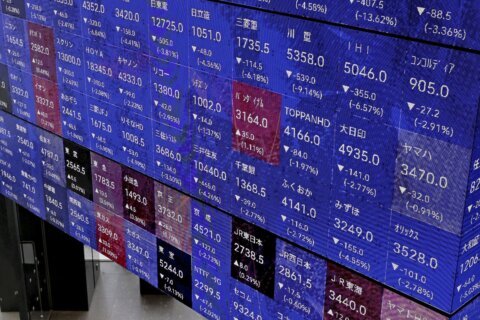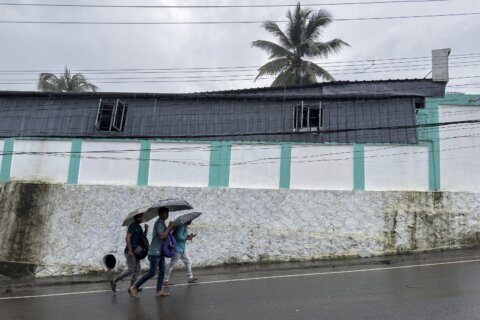AGRIGENTO, Italy (AP) — Lakes are dry and fields are scorched by heat in Sicily, but water is still gushing copiously for tourists.
After an almost totally rain-free year on the Italian island, fountains inside Agrigento’s famous archaeological park are still flowing, and pools in rows of hotels are full.
Like many Mediterranean islands, people in Sicily are used to long spells without rain, but human-caused climate change has made weather more erratic, and droughts can be longer and more frequent. Islanders are surviving as they have for decades – they store as much as they can in cisterns and use tankers to deliver water – and do it so well visitors that don’t feel the difference. But this year, the drought has gotten so bad that it’s putting residents at even greater risk, even as water still flows to hotels and tourist sites.
Resilience in a dry year
The drought is punishing. The local water basin authority has tightly rationed water for almost a million residents – they are allowed as little as two to four hours a week — to get through the summer. And on Friday, the first Italian navy tanker ship arrived to supply 12 million liters (3.2 million gallons) of water to the most affected residents.
But Agrigento residents are among the most drought-resilient in Italy, and even with rationing, they still run their businesses, hotels, bed-and-breakfasts, and households without missing a shower, neglecting their garden or closing the swimming pool.
“Nobody can cope with water shortage better than southern Sicilians,” said Salvatore Cocina, head of the local civil protection, who has the hard task of coordinating what little water is left on the island.
Water scarcity is not new as southern Sicily’s terrain does not hold much water and the aqueducts are leaking. The region is also prone to dry spells, particularly in the summer.
Most residents own a private cistern that can hold at least a thousand liters (264 gallons) of water. The city’s rooftops are dotted with large plastic tanks, and just as many are underground in gardens and basements.
Despite the water emergency, tourists continue to flock to the beautiful beaches of southern Sicily and line up to admire the vestiges of ancient Greek colonies.
“I did not have any problem with water,” said New Zealand tourist Iain Topp, as he sweated under the blazing sun during a visit to the 2,500-year-old temple of Concord. But he added that he was “told to conserve water because there could be a shortage.”
Gianluca, an Italian tourist from Lodi who didn’t give his last name, said “there are no problems with drought” in his experience and “at my hotel, they told me they have their own reserves, their cisterns.”
The Valley of Temples archaeological site, which its director said drew in over a million visitors last year, has also been prioritized, so doesn’t suffer from water scarcity.
“We have water 24/7,” explained director Roberto Sciarratta. “Our archaeologists are at work, the valley is open also at night with theater plays. We have no problems with water supplies.”
Meanwhile, water-scarce residents’ tactics are working reasonably well for now, but they have been facing exceptionally difficult circumstances.
2024 has been the worst year for rainfall in more than 20 years according to the civil protection regional department. Lake Fanaco, which supplies water to Agrigento province, used to collect up to 18 million cubic meters of water during an average rainy season, which normally runs from September to April. But by April the lake’s water was already below 2 million cubic meters and is now almost completely dry.
In May, the national government declared a state of emergency for drought and allocated 20 million euros ($21.7 million) to buy water tankers and dig new wells.
And temperatures in southern Sicily are currently 2 degrees Celsius (3.6 Fahrenheit) warmer than the 1991-2020 average, according to the Climate Shift Index, meaning water is quick to evaporate.
“If it does not rain in September, we will have to start tapping critical reserves, and wells and aquifers will also go below critical levels, not just our lakes,” said Cocina.
Solutions stretched thin
Salvatore Di Maria’s phone rarely stops ringing. He is a driver and owner of one of the main water tanker fleets in the area.
On a recent hot day, Di Maria picked up his phone as he filled his gleaming blue tanker at a public water station to yet another customer.
“I need 12,000 liters (3,170 gallons) of water,” said the voice on the other end, calling from a tourist resort.
“There is a waiting list of 10 to 15 days,” Di Maria answered.
Everyone asks him for water. Everyone wants to make sure they will not run out of water. Everyone wants to have full cisterns. And tankers are the best way to deliver the precious water directly to residents without leaks.
Dozens of tanker drivers speed along the winding roads delivering water to priority areas as determined by the local water company, AICA. Higher priority groups are sick or elderly people, hospitals, and several key businesses, such as hotels.
“The drought emergency was a wakeup call,” explained Settimio Cantone, president of AICA. “Our aqueduct leaks 50 to 60 percent of its water.”
“We are now digging new wells, fixing the entire waterworks and reactivating a desalination plant with the emergency funds. This will make our province more independent,” he said.
“Sicily is so vulnerable due to leaky pipes and obsolete and undersized infrastructures. It is not just climate,” said Giulio Boccaletti, scientific director of Euro-Mediterranean center on climate change.
In between visits from water tankers, several Agrigento residents make frequent trips to the only public fountain left open in town to fill their jerrycans on the way home.
Nuccio Navarra is one of those residents, filling up jerrycans from the Bonamorone fountain two or three times a day. “In my house we receive water every 15 days and the pressure is very low, and those who live on the upper floors cannot fill the cisterns,” he said.
Climate scientist Boccaletti fears for the future, although he noted that fixing water infrastructure and investing to adapt agriculture and engineering as AICA hopes to do could offset some concerns.
The Mediterranean basin “will experience higher temperatures, less rainfall and continued sea level rise during the coming decades,” according to the United Nations’ Intergovernmental Panel on Climate Change. The group dubbed the region a “climate change hotspot” due to the vulnerability of human society and ecosystems.
“What used to be extraordinary is the new normal,” said Boccaletti.
___
The Associated Press’ climate and environmental coverage receives financial support from multiple private foundations. AP is solely responsible for all content. Find AP’s standards for working with philanthropies, a list of supporters and funded coverage areas at AP.org.
Copyright © 2024 The Associated Press. All rights reserved. This material may not be published, broadcast, written or redistributed.







